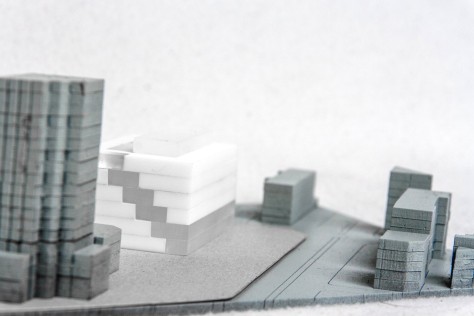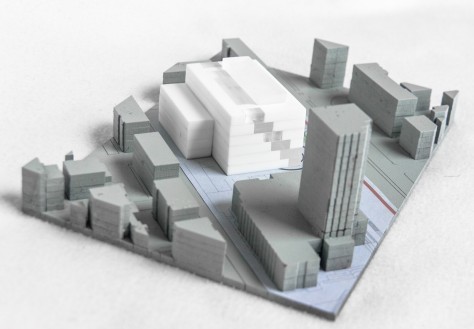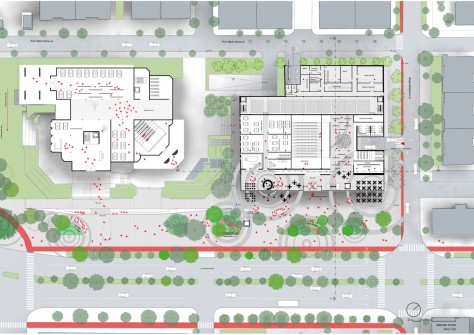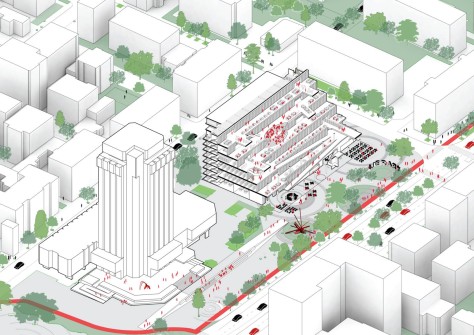
The city of Varna is a post war city with an extended sea front. The urban fabric presents rich diversity as it encompasses a range of small scale houses and large scale socialist architecture. The act of subtracting a large longitudinal void across the compact orthogonal volume suggests a symbolic gesture that creates ‘air’, space for the etheric body – the knowledge – to be developed.

The open space of knowledge divides therefore the mass of the building into two solid volumes, one in front of the Boulevard and one in the backside of the site. The back volume is fragmented in three large zones, so that on the back of the building a ‘spine’ is created, a well-structured verticality that accommodates the fundamental parts of the library – the archive and the administration. The slabs of the two remaining volumes are shifted; the void is distorted. The ground-based volume is shifted towards the city, opening up knowledge to the public.

Artificial, geometrical contour lines, forming a climax, bare the library’s fetish, the books and the book stacks; it is about the embracement and protection of the book. The climax unfolds till the ground floor and expands outside the building. The ’library’ is given back to the city. This linear zone (Lobby) is the most public space of the building.The floating volume, a condensed act of knowledge, is shifted towards the Source; an Act On the book; ‘devouring’ the books; absorbing knowledge; learning.

Organisation
Each level bears its own programmatic function. The cutting through void allows the transmission of light into the heart of the building, but also strong visual connections between floors and spaces. A ramp connects the ground, the first and the second floor of the building. This diagonal axis alters the quality of the space, creating a dynamic flow.

Programmatically it connects the most pubic part of the building, the ground floor, with the children’s and teenager’s space. Bridges on every level interconnect the reading rooms with the bookshelves areas. The vertical volume, the administration and the archive, structured in a denser way, can be accessed on all levels both through the building, but also form a separate entrance in the side road. The core interconnects vertically the archive, the administration and the loading zone, however each of these zones maintains different levels of accessibility and autonomy.

The biggest mass of the books and book stacks is accommodated on and within the climax volume. Among the bookshelves there are silent reading places. More diverse reading places can be found on the high raised level. Entering the building the visitor finds himself in the lobby, a linear zone that takes over the whole front of the building and develops along with the parallel, linear square in front of the building.

The lobby zone offers access to two different options: 1) on the left reaching firstly the ramp that leads the visitor to the upper levels, but also a zone of all the loud, group work and hand-on activities – registration/information desk, the souvenir shop, hobby zone, training center, conference rooms, individual work station, copy center, 2) on the right reaching the open, public, social zone – auditorium, exhibition area (storage), dressing rooms, stage storage, customer service, kitchenette, and storage.

The first part of the ramp leads to the first level, where an entrance zone welcomes the visitor to a second copy center, the serials desk and the IT lab. The first level accommodates the children zone – book collection and reading places, reading, games and events area, area for parents, circulation and reference desk, outdoor reading and playing area. A second ramp takes the visitor to the second level, the teenagers’ space – book collection and reading places, reference books, study and individual work area, hobby zone, circulation and reference desk, office desk and office supervisor.

Parallel to the second level begins the above floating volume that accommodates few bookshelves and mostly reading places. The access to the third floor is achieved by a round staircase. Different programmatic groups compose this level on both volumes; the Arts and Media center, the American corner and the Deutsche Lesesaal – the library items collection, hobby zone, circulation and reference desk for each one. The specialized reading areas are also placed on this floor – the local history and the rare and valuable documents (reading area, storage, and circulation and reference desk).

A small amphitheater brings the user from the third to the forth and fifth level which is exclusively dedicated to the adults section -book collections and reading places, individual and group work areas, circulation and reference desk. The fifth floors provides access to the sixth floor where a small pavilion resides, along with a small café, interior and outdoor reading areas.Source by Architects for Urbanity

Location: Varna, Bulgaria
Architects: Architects for Urbanity
Project Team: Irgen Salianji, Marina Kounavi, Katerina Petrocheilou, Liana Sofiadi, Karolina Szóstkiewicz
Status: 1st prize competition winner
Total Area: 17 500 m2
Parking Spots: 330
Year: 2015
Images: Courtesy of Architects for Urbanity










